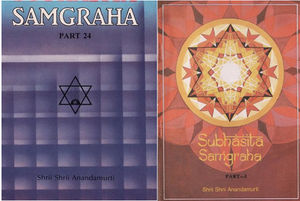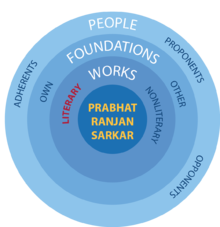Subhasita Samgraha: Difference between revisions
(References formatting) |
m (clean up, removed: {{Prabhat Ranjan Sarkar}}) |
||
| Line 26: | Line 26: | ||
| followed_by = | | followed_by = | ||
}} | }} | ||
'''Subhasita Samgraha''' ("Collected Discourses") is a series of 25 books, part of the vast literary heritage of [[Prabhat Ranjan Sarkar]] aka Shrii Shrii Anandamurti (1921–1990), that assembles 214 ''Dharma Mahacakra'' (DMC)<ref group=note>A spiritual [[:wikipedia:Ceremony|ceremony]] where the disciples [[:wikipedia:meditation|meditate]] in the presence of the [[:wikipedia:Guru|Master]] and He holds an important spiritual discourse and performs a special ''[[Mudra]]'' named ''Varabaja Mudra''.</ref> discourses given by the author.<ref group=note>Between 1955 and 1990 the author wrote in [[:wikipedia:English language|English]], [[:wikipedia: | '''Subhasita Samgraha''' ("Collected Discourses") is a series of 25 books, part of the vast literary heritage of [[Prabhat Ranjan Sarkar]] aka Shrii Shrii Anandamurti (1921–1990), that assembles 214 ''Dharma Mahacakra'' (DMC)<ref group=note>A spiritual [[:wikipedia:Ceremony|ceremony]] where the disciples [[:wikipedia:meditation|meditate]] in the presence of the [[:wikipedia:Guru|Master]] and He holds an important spiritual discourse and performs a special ''[[Mudra]]'' named ''Varabaja Mudra''.</ref> discourses given by the author.<ref group=note>Between 1955 and 1990 the author wrote in [[:wikipedia:English language|English]], [[:wikipedia:Bengali language|Bengali]] and [[:wikipedia:Hindi|Hindi]]. He wrote in the name "Shrii Prabhat Ranjan Sarkar" when treating [[:wikipedia:Sociology|sociology]], [[:wikipedia:Economics|economics]], [[:wikipedia:Philology|philology]] and various other subjects, and in the name ""Shrii Shrii Ánandamúrti"" when focusing on spiritual topics. Many of his books he gave as dictations; others were compiled from his discourses, some of them in small pocket-books.</ref> | ||
== Contents == | == Contents == | ||
The range of topics are linked to the sphere of spirituality and intuitional science. The first book ("''Subhasita Samgraha'' Part 1") starts with the speech "The Evolution of Society"{{sfn|Anandamurti |1957|p=5}} helded from the author at "Rampur colony", [[:wikipedia:Jamalpur, Munger|Jamalpur]] (India), on the occasion of his first DMC on January 1, 1955. | The range of topics are linked to the sphere of spirituality and intuitional science. The first book ("''Subhasita Samgraha'' Part 1") starts with the speech "The Evolution of Society"{{sfn|Anandamurti |1957|p=5}} helded from the author at "Rampur colony", [[:wikipedia:Jamalpur, Munger|Jamalpur]] (India), on the occasion of his first DMC on January 1, 1955. | ||
Chris Kang<ref group=note>School of History, Philosophy, Religion and Classics, The [[:wikipedia:University of Queensland|University of Queensland]], [[:wikipedia:Australia|Australia]].</ref> on his essay "Sarkar and the Buddha's Four Noble Truths",{{sfn|Kang|2002|p=20}} refers the Anandamurti's ''karma yoga'' vision described in the Part 1 (pp. | Chris Kang<ref group=note>School of History, Philosophy, Religion and Classics, The [[:wikipedia:University of Queensland|University of Queensland]], [[:wikipedia:Australia|Australia]].</ref> on his essay "Sarkar and the Buddha's Four Noble Truths",{{sfn|Kang|2002|p=20}} refers the Anandamurti's ''karma yoga'' vision described in the Part 1 (pp. 28–32) as "selfless action performed with the attitudes of: 1)relinquishing the desire for the fruits of action, 2)abandoning the vanity of performing an act and 3)surrendering all actions unto Brahma". | ||
The last book, "Subhasita Samgraha Part 25", unpublished in English, starts with "Rudra", the DMC's discourse given by the author on May 5, 1969 in [[:wikipedia:Ranchi|Ranchi]]<ref group=note>Ranchi is the capital of the Indian state of [[:wikipedia:Jharkhand|Jharkhand]].</ref> [[:wikipedia:India|India]]. | The last book, "Subhasita Samgraha Part 25", unpublished in English, starts with "Rudra", the DMC's discourse given by the author on May 5, 1969 in [[:wikipedia:Ranchi|Ranchi]]<ref group=note>Ranchi is the capital of the Indian state of [[:wikipedia:Jharkhand|Jharkhand]].</ref> [[:wikipedia:India|India]]. | ||
| Line 58: | Line 58: | ||
== External links == | == External links == | ||
[[Category:Works of Prabhat Ranjan Sarkar]] | [[Category:Works of Prabhat Ranjan Sarkar]] | ||
Revision as of 01:08, 11 November 2013
| Subhasita Samgraha (Parts 1 to 24)[note 1] | |
|---|---|
 "Subhasita Samgraha": the front covers of Parts 1 and 24 | |
| Author | Shrii Shrii Anandamurti |
| Language | English |
| Subject | Philosophy |
| Publisher | Ananda Marga Publications[3] |
| Publication date | 1957 (first edition) (IND)[1][2] |
| Media type | |
| ISBN | ISBN 81-7252-114-6 (Part 1) to ISBN 81-7252-114-6 (Part 24) |
| Location in Sarkarverse | |
Subhasita Samgraha ("Collected Discourses") is a series of 25 books, part of the vast literary heritage of Prabhat Ranjan Sarkar aka Shrii Shrii Anandamurti (1921–1990), that assembles 214 Dharma Mahacakra (DMC)[note 2] discourses given by the author.[note 3]
Contents
The range of topics are linked to the sphere of spirituality and intuitional science. The first book ("Subhasita Samgraha Part 1") starts with the speech "The Evolution of Society"[4] helded from the author at "Rampur colony", Jamalpur (India), on the occasion of his first DMC on January 1, 1955.
Chris Kang[note 4] on his essay "Sarkar and the Buddha's Four Noble Truths",[5] refers the Anandamurti's karma yoga vision described in the Part 1 (pp. 28–32) as "selfless action performed with the attitudes of: 1)relinquishing the desire for the fruits of action, 2)abandoning the vanity of performing an act and 3)surrendering all actions unto Brahma".
The last book, "Subhasita Samgraha Part 25", unpublished in English, starts with "Rudra", the DMC's discourse given by the author on May 5, 1969 in Ranchi[note 5] India.
References
Footnotes
- ^ Part 25 unpublished in english.
- ^ A spiritual ceremony where the disciples meditate in the presence of the Master and He holds an important spiritual discourse and performs a special Mudra named Varabaja Mudra.
- ^ Between 1955 and 1990 the author wrote in English, Bengali and Hindi. He wrote in the name "Shrii Prabhat Ranjan Sarkar" when treating sociology, economics, philology and various other subjects, and in the name ""Shrii Shrii Ánandamúrti"" when focusing on spiritual topics. Many of his books he gave as dictations; others were compiled from his discourses, some of them in small pocket-books.
- ^ School of History, Philosophy, Religion and Classics, The University of Queensland, Australia.
- ^ Ranchi is the capital of the Indian state of Jharkhand.
Citations
- ^ Subhasita Samgraha Part 1.
- ^ Subhasita Samgraha Part 24.
- ^ Ananda Marga Publications.
- ^ Anandamurti 1957, p. 5.
- ^ Kang 2002, p. 20.
Sources
- Anandamurti, Shrii Shrii (1957), Subhasita Samgraha Part 1 to 25, Kolkata: Ananda Marga-Ananda Printers
Online sources
- Ananda Marga Publications (2012) "Ananda Marga Publications web site" Ananda Marga Publications retrieved 3 January 2013
- Subhasita Samgraha Part 1 on the publisher's site "Subhasita Samgraha Part 1 on the publisher's site" Ampublications.org retrieved 23 December 2012
- Subhasita Samgraha Part 24 on the publisher's site "Subhasita Samgraha Part 24 on the publisher's site" Ampublications.org retrieved 2012-12-23
- Kang, Chris (2002) "Sarkar and the Buddha's Four Noble Truths" p. 29 retrieved 1 January 2013
